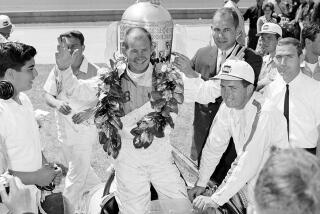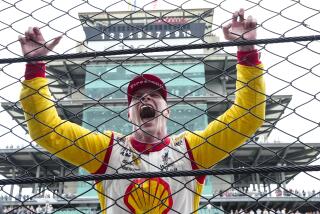‘We’ve Lost Dale Earnhardt’
- Share via
DAYTONA BEACH, FLA. — Since the day he came out of Kannapolis, N. C., a high school dropout with a passion for driving a race car, Dale Earnhardt has lived the American dream.
Over 25 years, he grew from a hard-nosed, inarticulate kid with a chip on his shoulder to a polished, professional sportsman who was as at ease in corporate board rooms as he was strapped inside the cockpit of a 200 mph stock car, becoming the greatest driver of his era. In 1998, the year of his only Daytona 500 win, he addressed the National Press Club in Washington, D. C.
He won seven Winston Cup championships, sharing the record with Richard Petty, but he did it against much more formidale competition.
As Bill France, longtime NASCAR president and now its chairman of the board said, “NASCAR has lost its greatest driver ever.”
He was called “Ironhead,” the “Intimidator” and “The Man in Black,” and worse things than that by hordes of fans who rooted against his familiar black No. 3 Chevrolets. As he grew into one of NASCAR’s elder statesman, and fan’s boos were aimed at Jeff Gordon and Rusty Wallace, Earnhardt became a crowd favorite.
Earnhardt’s reputation in North Carolina is so strong that it was once said that children learning to count in elementary school, say, “One, two, Earnhardt, four...”
When Earnhardt was killed Sunday on the final turn of the Daytona 500, he was doing what he did best--charging as hard as he could to catch the cars ahead of him and to stay in front of the pack trying to catch him. Up front were his son, Dale Jr., and the driver of a car owned by Dale Earnhardt Inc., Michael Waltrip.
Waltrip was waiting in Victory Lane for him, not even knowing he had been in an accident until told by Ken Schrader, whose car was involved in Earnhardt’s crash. Dale Jr., on hearing that his father might be hurt, started running the nearly half-mile from the start-finish line to where Dale Sr. was being lifted into an ambulance.
The ambulance pulled away before Little E got there.
Earnhardt had led four times for 17 laps and was running third behind Waltrip and Junior on the final lap as the leaders were lapping slower cars. Each time Earnhardt attempted to power his way to the front, he was blocked by his team driver and his son.
As he shot up the 31 degree banking for the final time, Sterling Marlin appeared to tap the rear of his car. On the banking, it was impossible to save the car, which shot up the incline and hit the wall at about a 75 degree angle. Caught with no place to so, Ken Schrader plowed into him, sending Earnhardt’s car down on the apron.
Meanwhile, up ahead, Waltrip and Little E were charging to the finish line, unaware of the crash behind time.
“I found out Dale was hurt from Ken Schrader,” Waltrip said, still unaware of the fatal outcome. “He came to Victory Lane to give me a heads-up. He said that he thought he was hurt. I’ve asked everybody I could find, and I haven’t been told anything other than what Schrader told me.”
From the day Earnhardt drove his first race at Daytona International Speedway, July 4, 1978, and finished seventh in the Pepsi 400 in a Ford, he had a special affinity for the place. It took him 20 years to win his first, and only, Daytona 500 in 1998, but along the way he won two Pepsi 400 Winston Cup races, seven Busch Grand Nationals, 12 Twin 125s, including 10 in a row from 1990 to 1999; six Budweiser Shootouts and six International Race of Champions.
He had won at least one race here in every year since 1989, but before Sunday he had not won this year. He was battling for the lead in the IROC on Friday before former Indianapolis 500 winner Eddie Cheever ran him into the grass in the first turn, giving the win to Dale Jarrett. “I’ve got one shot left, maybe it’s a good omen for the 500,” he said after the IROC race.
His disappointments at not winning the 500 were legend.
In 1990 he was leading by a wide margin when his tire went flat on the last turn of the race and little regarded Derrike Cope went past to win. In 1993 he was passed by Dale Jarrett on the last lap. And in 1995 he was leading with 10 laps remaining when Marlin went by to win.
He loved to represent NASCAR in the International Race of Champions, showing his prowess to drivers from other series. He won the IROC championship four times.
In 1994 he became the third modern-era driver to win four consecutive races. He won more races at Atlanta Motor Speedway (nine) and Talladega (10) than any one else.
Although he won the last of his seven Winston Cup championships in 1994 and was approaching 50 (on April 29), he said earlier this year that he was planning to seriously challenge for an eighth title this year. Last year, after several disappointing seasons in which he had numerous injuries, he came back to finish second behind Bobby Labonte.
Earnhardt’s most serious injury came in 1996 at Talladega, where he broke his collarbone and sternum. Two weeks later, taped up and having to be helped into his car, he won the pole on a road course in Watkins Glen, N. Y., breaking the track record.
After building his racing foundation as a teenager on the short tracks in the Carolinas, where his father, Ralph, worked and won the NASCAR late model sportsman championship, Dale drove his first NASCAR race in the 1975 World 600 at Charlotte Motor SPeedway. He started 33rd and finished 22nd, one position ahead of future car owner Richard Childress.
Six of Earnhardt’s seven Winston Cup titles were won in Childress’ cars. His first was in 1980 for Rod Osterlund when he became the only driver to win rookie of the year and the championship back-to-back.
During his career, he made 676 starts, won 76 races--sixth on the all-time list and was first among active drivers--and had 428 top 10 finishes. He won his first race April 1, 1979, at Bristol.
He is stock car racing’s all-time money winner with earnings of $41,939,662 on the race track. This figure has multiplied many times by his Dale Earnhardt Inc. business enterprises, which included his three-driver Winston Cup team of his son, Michael Waltrip and Steve Park.
Some of his favorite racing moments have come in competition with his son, Dale Jr., although he gave no quarter when it came to winning. Another son, Kerry, also races in the Busch series. His oldest daughter, Kelly, also raced at track around North Carolina.
In his off-time, Earnhardt works on his large farm in Mooresville, N.C., attends Atlanta Braves baseball games or drives his 110-foot Hatteras. The powerboat is harbored in the Bahamas, but he used it as family sleeping quarters during SpeedWeeks this year in Daytona. Before begining preparation for the 500, Earnhardt and his son drove a Corvette in the 24 Hours of Daytona and finished fourth overall. It was his first sports car race.
There were no drivers available for comment after his death became known as they had all left the speedway grounds and headed for home.
The annual induction of the winning Daytona 500 car into Daytona USA, scheduled for this morning, was cancelled. NASCAR officials said it will be rescheduled at a later date.
(BEGIN TEXT OF INFOBOX / INFOGRAPHIC)
BY THE NUMBERS
676: Winston Cup races in 27 years earning $41,640,462
76: Winston Cup wins in a career spanning four decades
7: Winston Cup championships for the 49-year-old driver
1: Number of victories at the Dayton 500
(BEGIN TEXT OF INFOBOX / INFOGRAPHIC)
IN QUOTES
“Dale Earnhardt transcended NASCAR.”
DAN DAVIS, FORD RACING
*
“NASCAR has lost its greatest driver ever.”
BILL FRANCE, JR., NASCAR CHAIRMAN
More to Read
Go beyond the scoreboard
Get the latest on L.A.'s teams in the daily Sports Report newsletter.
You may occasionally receive promotional content from the Los Angeles Times.










